Effective coaching is essential for every successful contact centre and BPO. Customer satisfaction, employee performance, and business outcomes all rely on effective coaching practices to thrive.
However, in many contact centres, coaching has traditionally focused on call monitoring and quality analysis (QA), often overlooking the value of collaborative development with advisors.

As Kim Ellis, GO GINGER learning solutions, highlights “Coaching shouldn’t involve just telling someone what they need to do and where they need to improve, it should be about working collaboratively to enhance the advisor’s performance.”
For many years, call centre coaching has been used as a way to tell people what is wrong, but if we want advisors to be enthusiastic about learning, training needs to be a positive and, as mentioned, a collaborative experience.
Eight Call Centre Coaching Models
With a variety of coaching models available, choosing the right approach can be challenging, and important to understand the strengths and applications of each framework so you can make your sessions more focused, effective, and rewarding.
To help we have put together information about some of the different coaching models so you can find one that works for you and your agents.
1. The GROW Model
The GROW coaching model is a powerful tool that helps call centre advisors identify their own coaching opportunities, as you ask them questions just like the four below.
The GROW model is made up of the following steps:
- GOAL – What do you want?
- REALITY – Where are you now?
- OPTIONS – What could you do?
- WILL – What will you do?
This model uses lots of open questions, which makes the advisor take control of their self-improvement. So you’re not just telling the advisor what they could do differently, you’re helping them get to a stage of self-realization.
By doing this, the advisor is fully aware of their skill gap, as they’ve drawn their own conclusions, rather than simply receiving feedback from you. This increases their motivation to improve in this area as they are more invested in the solution.
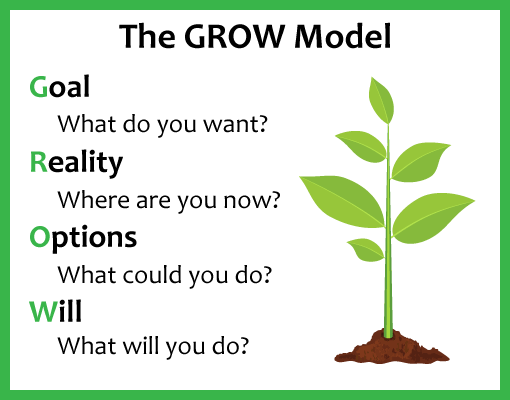
It’s important to note that while the four questions are fundamental, there’s room for creativity in how you ask them.
As Kim warns “while this can be a very helpful tool in helping advisors to realize where they can improve, it is easy for the coach to stick to this model too rigidly, rather than adjusting to suit the individual advisor’s needs.”
What we mean by this is that it’s easy just to stick to the four questions above, without becoming more creative with your questioning to help advisors see their mistakes.
Remember, what seems obvious to you may not be immediately clear to the advisor. Asking the right questions, without directly telling them what’s wrong, can be a tricky task, but it’s essential for encouraging deep reflection and meaningful growth.
2. The STAR Model
The STAR coaching model focuses on providing specific, actionable feedback based on real-life examples.
It helps advisors better understand what they did well and where they can improve by breaking down their performance into clear, structured components.
The STAR model is as follows:
- SITUATION – What was the context or scenario?
- TASK – What was the goal or objective?
- ACTION – What actions did the advisor take?
- RESULT – What was the outcome or result of those actions?
In this model, the coach provides feedback based on a specific situation, task, and the actions the advisor took to address it.
By focusing on concrete examples, the STAR model helps the advisor understand exactly what went well and what could be improved in a real-world context. This makes the feedback more relatable and actionable.
The STAR model encourages advisors to think critically about their approach by breaking down the call into manageable components.
The coach can then guide them through each part, asking them what they did in each area and how they can improve for future calls.
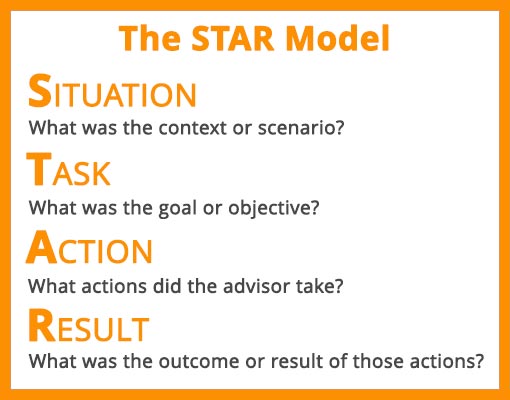
This method is effective for identifying specific strengths and areas of improvement, allowing advisors to focus on practical skills rather than just abstract feedback.
This model works well for giving both positive and constructive feedback, making it a versatile tool for coaches. Since it is grounded in real examples, it’s particularly useful for offering clear, understandable feedback that advisors can directly apply to their next customer interactions.
3. The OSCAR Model
The OSCAR model is beneficial in helping employees think through challenges and actively work on skills improvement, as it guides call centre advisors through a structured process of self-discovery and improvement by asking a series of open-ended questions.
The OSCAR model involves these steps:
- OUTCOME – What do you want to achieve?
- SITUATION – What is the current situation?
- CHOICES – What options are available to you?
- ACTIONS – What will you do next?
- REVIEW – How will you measure success?
This model encourages a collaborative approach to coaching, where the advisor actively participates in the problem-solving process, and the coach helps the advisor gain clarity on their goals and the actions they need to take.
By guiding through the process with thoughtful questions (not direct instructions), you help the agent explore their situation, identify possible solutions, and decide on a course of action that works best for them.
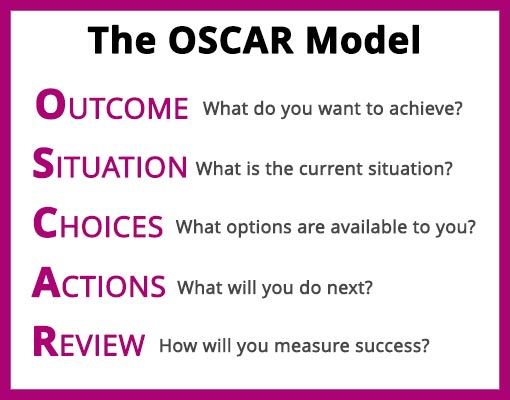
By using the OSCAR model, the advisor is more likely to feel responsible for their own growth. Since they are the ones identifying the situation and choosing the solution, they are more likely to feel empowered and motivated to make improvements.
It’s important to remember that while the OSCAR model provides a clear framework, there’s always room for creativity in your questioning.
Just like with any coaching model, it’s easy to stick to the basic steps without pushing for deeper exploration, but the key is asking the right questions that prompt reflection and help the advisor discover their own insights, rather than simply giving them the answers.
4. The CLEAR Model
The CLEAR coaching model focuses on creating a supportive environment where the call centre advisor can openly reflect on their performance and set actionable goals.
The CLEAR model stands for:
- CONTRACT – What is the goal of the coaching session?
- LISTEN – What is happening right now?
- EXPLORE – What are the potential options for improvement?
- ACTION – What will you do to improve your performance?
- REVIEW – How will progress be tracked and evaluated?
This model encourages collaboration between the coach and the advisor, aiming to clarify expectations and make sure the advisor feels confident in the next steps toward improvement.
The model’s key strength is its focus on mutual understanding from the outset.
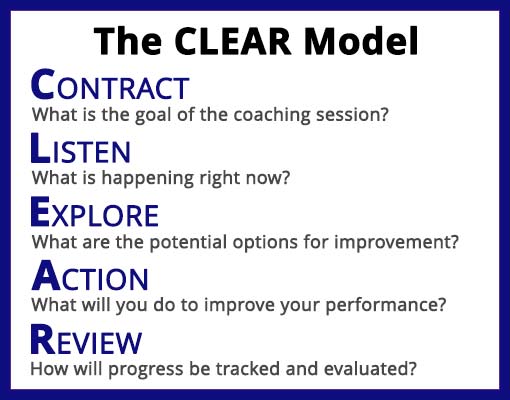
The Contract step ensures both coach and advisor are aligned on the session’s goals, helping to focus on specific areas for improvement.
In the Listen and Explore stages, the coach encourages the advisor to reflect critically on their performance, guiding them to uncover their own insights rather than just providing feedback. This empowers the advisor and increases their sense of ownership in their development.
The Action and Review steps provide clear direction, ensuring the advisor knows what actions to take and how progress will be tracked. This structured follow-up enhances the long-term impact of coaching and keeps the advisor focused on their goals.
The CLEAR model fosters accountability by involving the advisor in the process, boosting their commitment to improvement. While the model provides a clear framework, the coach’s ability to adapt and respond to the advisor’s needs is key to its success.
5. Two Stars and a Wish Model
The Two Stars and a Wish model is a simple yet effective coaching tool that helps call centre advisors reflect on their performance in a balanced way.
It involves giving the advisor two stars for things they did well during a call, and one wish for an area where they could improve.
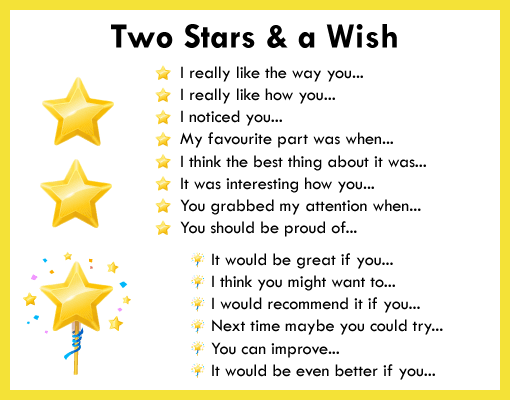
Unlike the GROW or OSCAR models, which encourage self-reflection through open-ended questions, the Two Stars and a Wish model focuses on direct feedback. This makes it a great tool for highlighting strengths while still addressing areas for growth.
The emphasis on finding two positives for every negative helps foster a more positive coaching environment. Finding positives in the advisor’s performance is important if you want to develop more positive attitudes around coaching in your contact centre.
So, if we follow this model, we are looking for two positives for each negative and this negative is “gift-wrapped” as a wish to avoid sound overly critical.
To avoid sounding overly critical when providing the wish, it’s important to frame it carefully. Phrasing it as “It would be great if you…” or “It would be even better if you…” makes the suggestion feel more like a constructive opportunity than a criticism.
However, this model also has a drawback, as Kim says: “It mostly uses statements, it doesn’t use open questions. This means that the advisor often doesn’t have time to respond to anything, which can limit coaching opportunities.”
With this in mind, the advisor may disregard the coach’s “wish”, believing it to be a “one-off” and therefore become less proactive in changing their behaviour.
This model works best for providing written feedback, as it is more informational than interactive. It’s not as collaborative as other models but is effective for offering quick, clear feedback that the advisor can use to reflect on their performance.
6. The THINK Model
The THINK model serves as a simple checklist to ensure that feedback given to call centre advisors is as thoughtful and beneficial as possible.
It’s designed to make sure that the advice you offer is constructive and focused on the areas that matter most to both customers and the advisors themselves.
It’s also easy to remember as everyone know the classic “think before you speak”, which is always a good policy, no matter what or how we feel.
The THINK model stands for:
- TRUE – Is it True?
- HELPFUL – Is it Helpful?
- INSPIRING – Is it Inspiring?
- NECESSARY – Is it Necessary?
- KIND – Is it Kind?
It is critical that the feedback you give is well thought out and this model encourages coaches to think carefully before providing feedback, ensuring that the advice is relevant, clear, and encouraging.
After all, we want advisors to be investing their time and energy into developing the skills that matter most, both to customers and to the advisors as individuals.
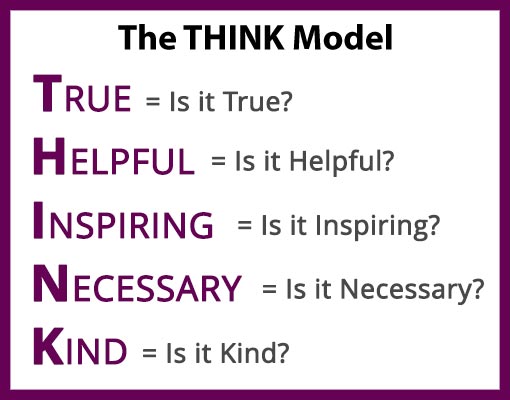
By using the THINK checklist, the coach can focus on delivering feedback that empowers the advisor to improve, rather than just highlighting mistakes. This ensures the feedback is well-received and helps foster a positive coaching relationship.
The THINK model is particularly effective when used alongside other models, like GROW or OSCAR, as it helps to guide the tone and quality of the feedback.
While it provides a great framework for preparing feedback, it is best used as part of a broader coaching strategy, not as a standalone approach.
Using it in conjunction with other models ensures that the feedback is not only thoughtful but also actionable and aligned with the advisor’s development goals, ensuring that the feedback remains impactful and drives lasting improvement.
7. The SBI Model
The SBI model provides a clear and focused approach to giving feedback by breaking it down into three key components: Situation, Behaviour, and Impact. This structure helps ensure feedback is specific, actionable, and easy to understand.
The SBI model involves these steps:
- SITUATION – What was the context?
- BEHAVIOUR – What specific behaviour was observed?
- IMPACT – What was the impact of that behaviour?
This model removes ambiguity, focusing on specific actions rather than generalities. The coach describes the situation clearly, identifies the behaviour that occurred, and then explains the impact that behaviour had.
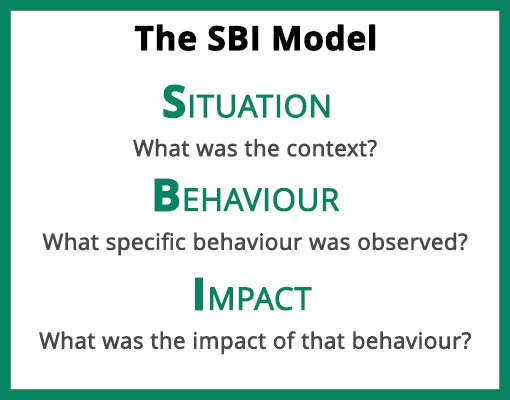
One of the strengths of the SBI model is its focus on concrete examples. Rather than offering vague or abstract feedback, it highlights specific behaviours, making it easier for the advisor to see what they need to change.
Additionally, the model helps the advisor understand the real-world consequences of their actions, fostering a deeper sense of accountability.
This model works well in situations where clear, actionable feedback is needed, and is particularly useful for real-time coaching. It’s simple, easy to remember, and ensures that feedback is focused and relevant, leading to better outcomes for both the advisor and the customer.
8. The SCC Model
The SSC model is a straightforward and effective coaching tool that helps advisors understand what they need to improve and what they should keep doing well. It focuses on three key areas: Stop, Start, and Continue, offering clear and actionable feedback.
The SSC model consists of:
- STOP – What behaviours or actions should the advisor stop doing?
- START – What new behaviours or actions should the advisor start doing?
- CONTINUE– What is working well that the advisor should continue doing?
This model is simple yet powerful, providing a clear structure for feedback that is easy for both the coach and advisor to understand.
By identifying things to stop, start, and continue, the model ensures that feedback is balanced and focused on both improvements and reinforcing positive actions.
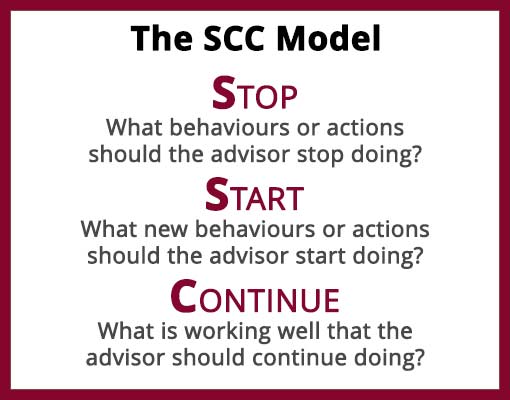
The SSC model is particularly effective when quick, actionable feedback is needed. It helps advisors gain clarity on specific areas for improvement, while also reinforcing the positive behaviours they should keep up.
This model is also useful for coaching sessions that focus on short-term goals or during performance reviews, helping advisors make immediate improvements with clear, easy-to-follow steps.
Applying These To Real Time Coaching
These coaching models are great to apply to real-time coaching, as this is a time when advisor engagement and self-awareness are at a high level.
Also, it’s great for the coach because, by working closely with advisors, we get more of a personal understanding of the contact’s context, which will – over time – improve both our coaching and communication skills.
So we put together three methods for real-time coaching, and highlight their pros and cons to identify how we can best use them in alignment with the coaching models above.
Face to Face
Face-to-face coaching involves listening back to call recordings with the advisor, typically in a private room, and discussing their performance.
This is a direct approach, meaning that you are offering direct feedback which is likely to be fully absorbed by the advisor, as you are speaking to them on a one-to-one basis.
From this direct conversation, “We can read the advisor’s facial expressions and body language, making it much easier to gauge their response to our feedback. This helps us to foster a better advisor–coach relationship.”
However, the drawback with this strategy is that advisors may at first feel uncomfortable listening back to their own voice, which can make for quite an intimidating scenario – unless managed properly.
In addition, being in the private room and receiving negative feedback, if the latter is indeed the case, it is easy for the advisor to feel as though they are being called into the teacher’s office for a telling-off.
With this in mind, if you do this it is best to use a coaching method that encourages open conversation, and align it with another that allows you to cultivate a positive discussion.
Side by Side
Side-by-side coaching is when you sit next to an advisor and listen in on one of their live contacts, before sharing your feedback once it comes to an end.
This coaching technique can be great because you’re giving advisors feedback directly after the contact, so it’s very relevant, and these immediate learnings are most likely to “stick” in the advisor’s mind. It also helps to blur the lines between the training room and the contact centre floor.
Another benefit is that you can get a good feel for how advisors react in different situations because you can see it in real time. Their facial cues may give you insights that would otherwise go unnoticed.
Yet this coaching technique also has its downsides, as Kim explains: “An advisor may feel intimidated by your presence during the call and may overlook your feedback, believing that their performance was negatively influenced by having you sitting next to them.”
This might well have been the case, as it is understandable for an agent to become nervous in such a scenario and make mistakes that they ordinarily wouldn’t.
So, it is good to use a coaching model that facilitates open conversation. If the advisor tells you that they realize that they’ve made the mistake, but it was only because they were nervous, do some remote listening – as explained below – to find out if that was indeed the case.
Remote Listening
Remote listening involves listening to an advisor’s call recording and offering feedback after. This is how most contact centres score calls during quality monitoring.
With this option, “You can really go through calls one after the other – to find the one that provides really valuable learnings, without having to discuss each one with the advisor, who you have taken off the phones.”
So while it’s great for finding specific types of calls, it is also a great coaching tool for training homeworkers, to help ensure they are continuing their learning and development.
We just need to be careful when we are using this coaching method that we don’t fall into the trap of just looking for “coaching opportunities” and focusing too much on the negatives.
There is also the issue that, without there being a one-to-one conversation, there is no “instant learning”. So, the advisor may have forgotten about the contact that you are trying to coach them on – obscuring any feedback they receive.
To help avoid these two issues, we firstly want to employ a coaching model that guards against being overly negative and combine it with another to ensure that the feedback we’re giving is constructive.
Then, alongside any written feedback we share with advisors, we should share a copy of the original call recording, to ensure the advisor hears the context behind your comments. The DAS contact centre in Caerphilly does this.
To find out more tips from DAS, read our article: 15 Things You Can Learn from the DAS Contact Centre
For more on contact centre coaching, read our articles:
- 9 Fun Customer Service Training Exercises
- How to Train Active Listening in the Contact Centre – With Four Exercises
- How to Improve Agent Performance in the Call Centre – With a Checklist
Author: Charlie Mitchell
Reviewed by: Robyn Coppell
Published On: 19th Aug 2019 - Last modified: 10th Dec 2024
Read more about - Skills, Charlie Mitchell, Coaching, Customer Service, Kim Ellis, Training







































